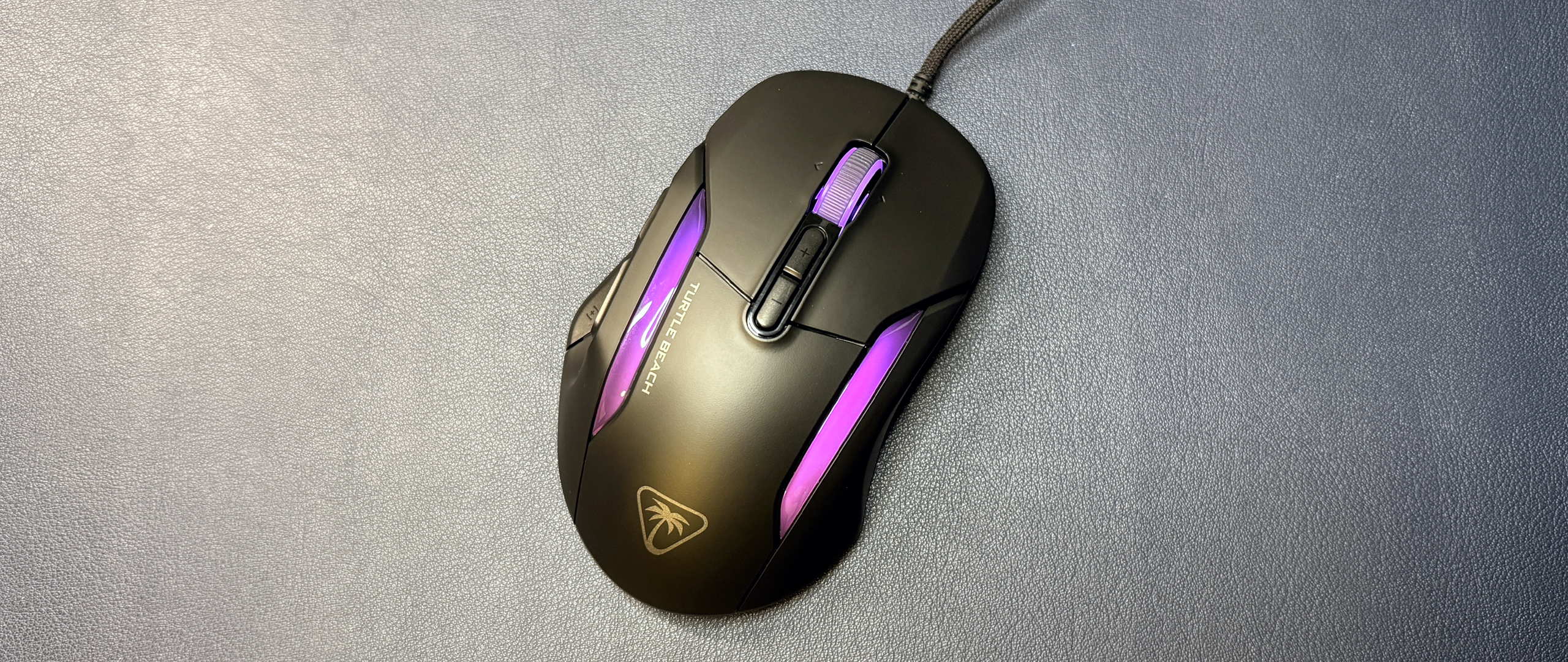Tom's Hardware Verdict
The Kone II is a large, comfortable wired gaming mouse with a 4-way tilt wheel and a reasonable price.
Pros
- +
Comfortable
- +
Minimal cable drag
- +
4-way tilt wheel
Cons
- -
Large and bulky
- -
Slippery finish attracts fingerprints
Why you can trust Tom's Hardware
At the beginning of this year, Turtle Beach decided to retire Roccat and completely absorb the brand, but that doesn't mean it's doing away with Roccat's peripheral lines. The new Turtle Beach Kone II (and its wireless counterpart, the Kone II Air) is the latest addition to the Kone line of gaming mice, and it occupies an interesting niche.
Okay, I'm not really sure what niche that is. Mid-range RPG gaming mouse?
The Kone II is definitely a change from the speed- and performance-focused stripped-down mice with 8,000 Hz polling rates we've been seeing way too many of lately, but it's not particularly budget-friendly at $70 (which is on the pricier side for a wired gaming mouse). It's big, but it's not too clunky, and it's surprisingly comfortable. It sports an ergonomically contoured chassis, seven programmable buttons, a 4-way tilt wheel, and it even retains some of the Kone line's bright, AIMO-infused RGB lighting (albeit in a much subtler way than we've seen in some of the lineup). It's packed with Turtle Beach's latest Owl-Eye 26K optical sensor, which has a maximum sensitivity of 26,000 DPI and a maximum speed of 650 IPS, and can handle up to 50 G's of force.
The Kone II might be a little confusing in terms of where it fits (if it fits) on our list of best gaming mice, but there's no denying that it's very, very comfortable. Combined with the brand's latest sensor and some pretty lighting, it's not the worst way to spend $70. The Kone II comes in both black and white colorways and also comes in a wireless version, which is pricier at $120.
Design and Comfort of the Kone II
The Kone II is a seven-button wired gaming mouse with a contoured, right-handed design and a tilt wheel. It's a fairly large mouse, measuring 5.13 inches (130.2mm) long by 3.25 inches (82.6mm) wide, and 1.72 inches (43.6mm) high at its thickest point — definitely larger than the Kone XP Air, and it's one of the bulkier mice we've tested. It weighs 3.17 ounces (90g), which puts it on the lighter side (for non-lightweight mice) — it's certainly lighter than it appears.
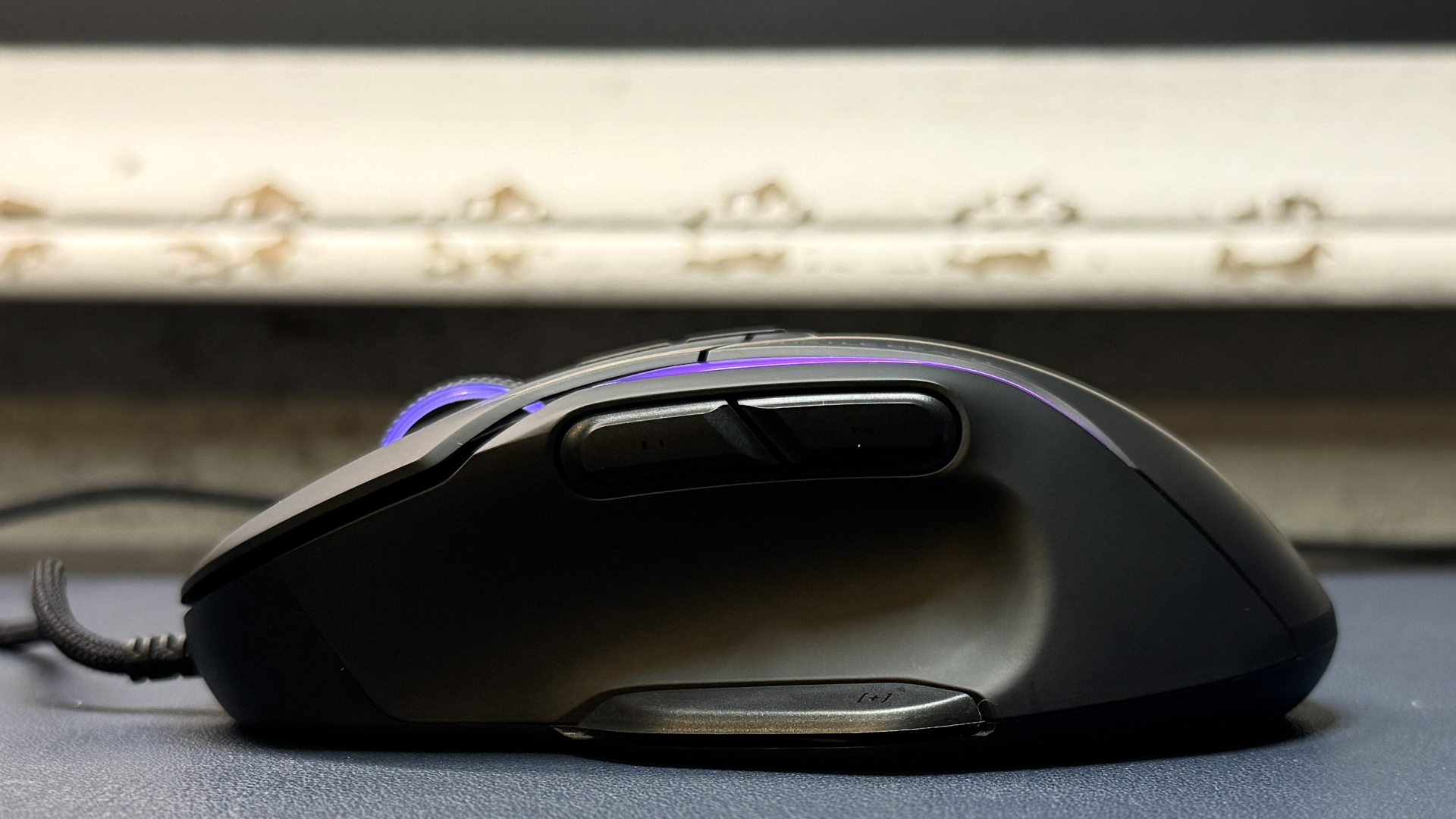
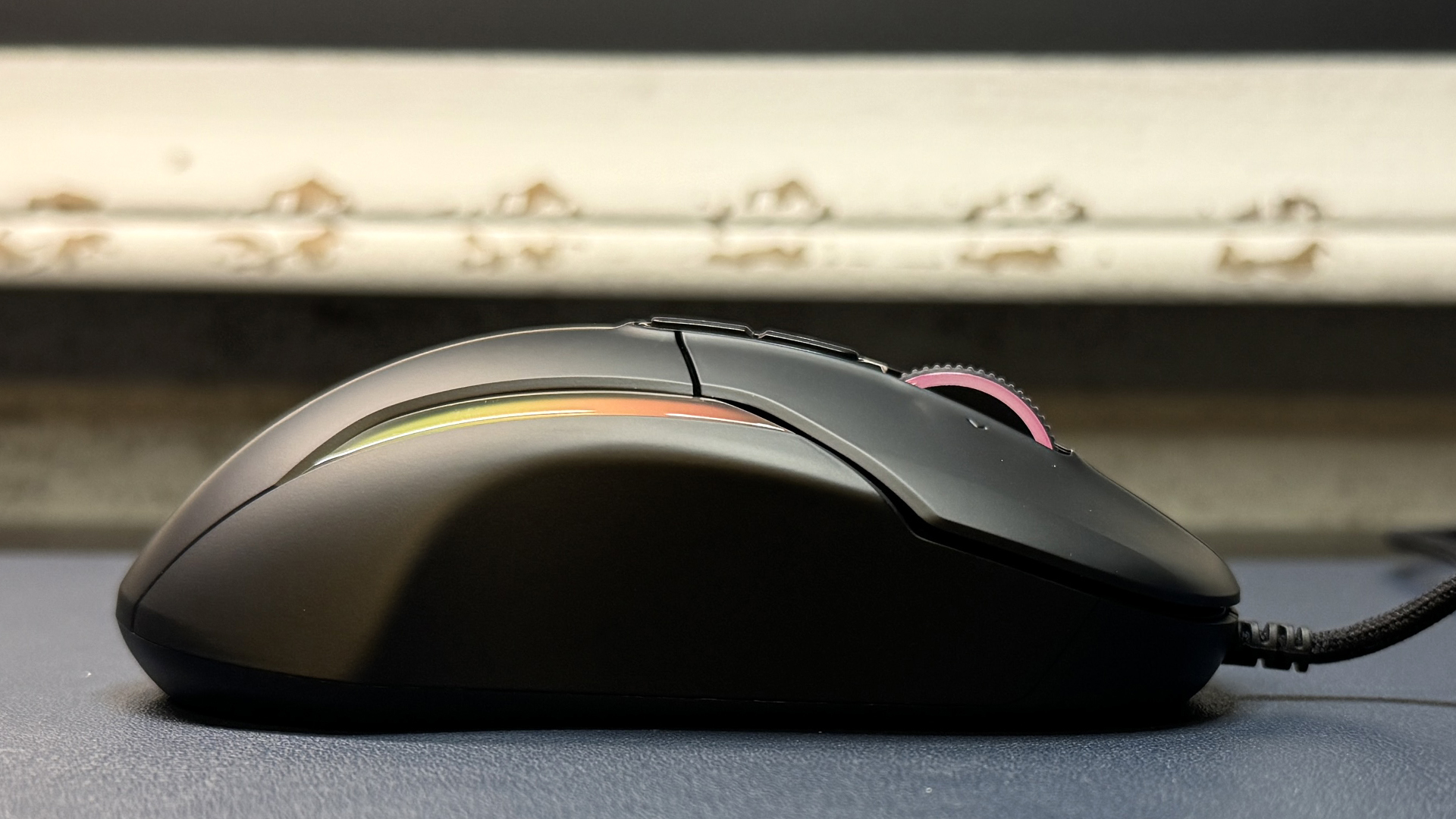


Despite its bulky design (or perhaps because of it), the Kone II is a very comfortable mouse. It has a soft, rounded ergonomic shape that fits nicely in your palm — though you won't forget you're holding a mouse. It has contoured sides to help with grip, but it's definitely a mouse for larger hands. You'll still be able to hold it with smaller hands, but you might have trouble reaching all of the buttons comfortably.
The mouse comes in both black and white colorways (our review unit was black) and features a smooth, matte finish with Turtle Beach's palm tree logo printed in silver on the palm rest. The mouse's smooth finish definitely attracts fingerprints and oil, and is pretty slippery overall — even with the grip tape in place, this wasn't the easiest mouse to pick up thanks to its general bulkiness.
Get Tom's Hardware's best news and in-depth reviews, straight to your inbox.
The mouse has two glossy RGB light strips along its sides, as well as RGB lighting in its tilt wheel. The Kone II isn't a particularly refined-looking mouse, but I do like the gradient of the light strips and the lighting looks very good — especially with the brand's unique AIMO lighting preset enabled.
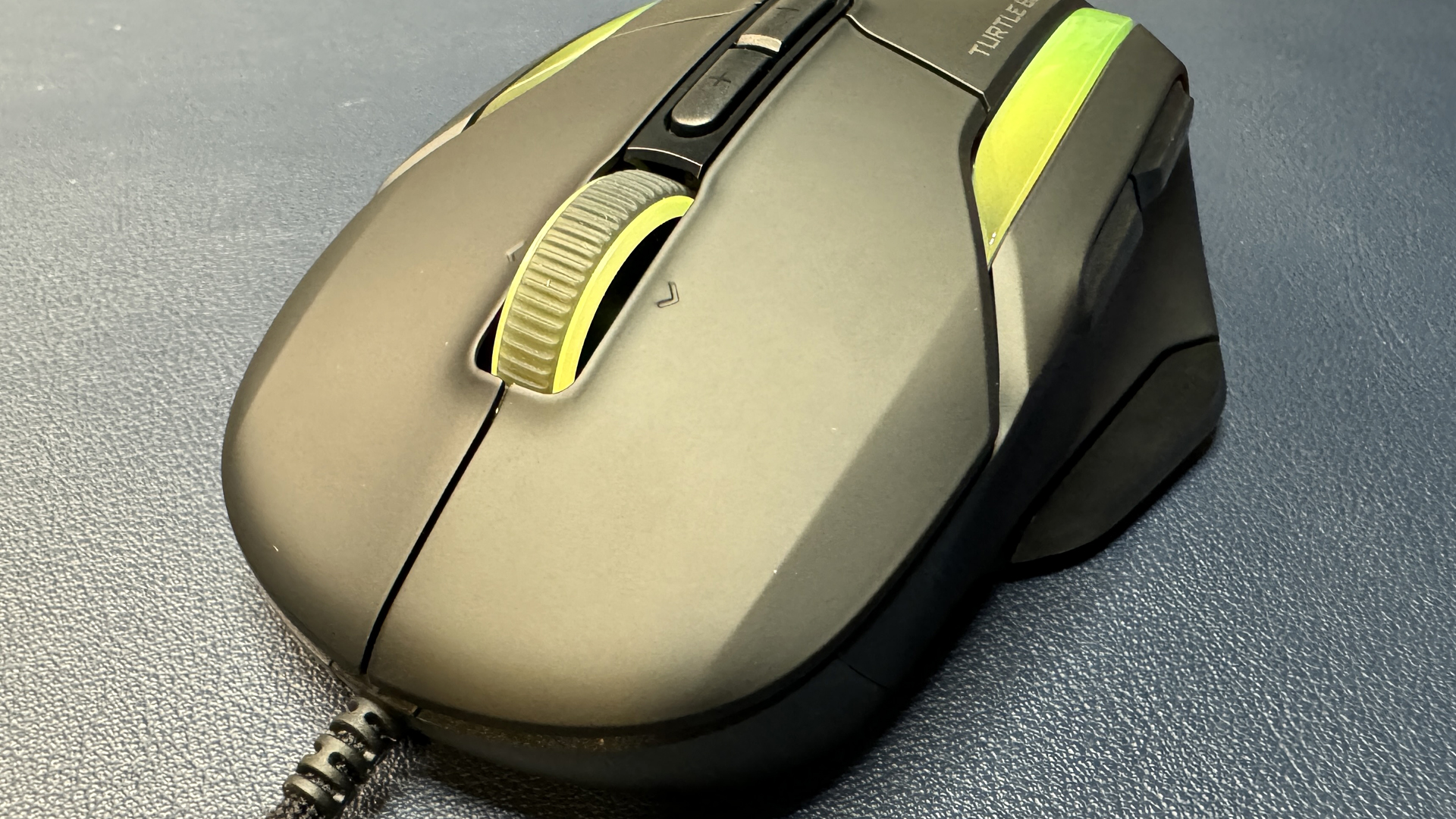
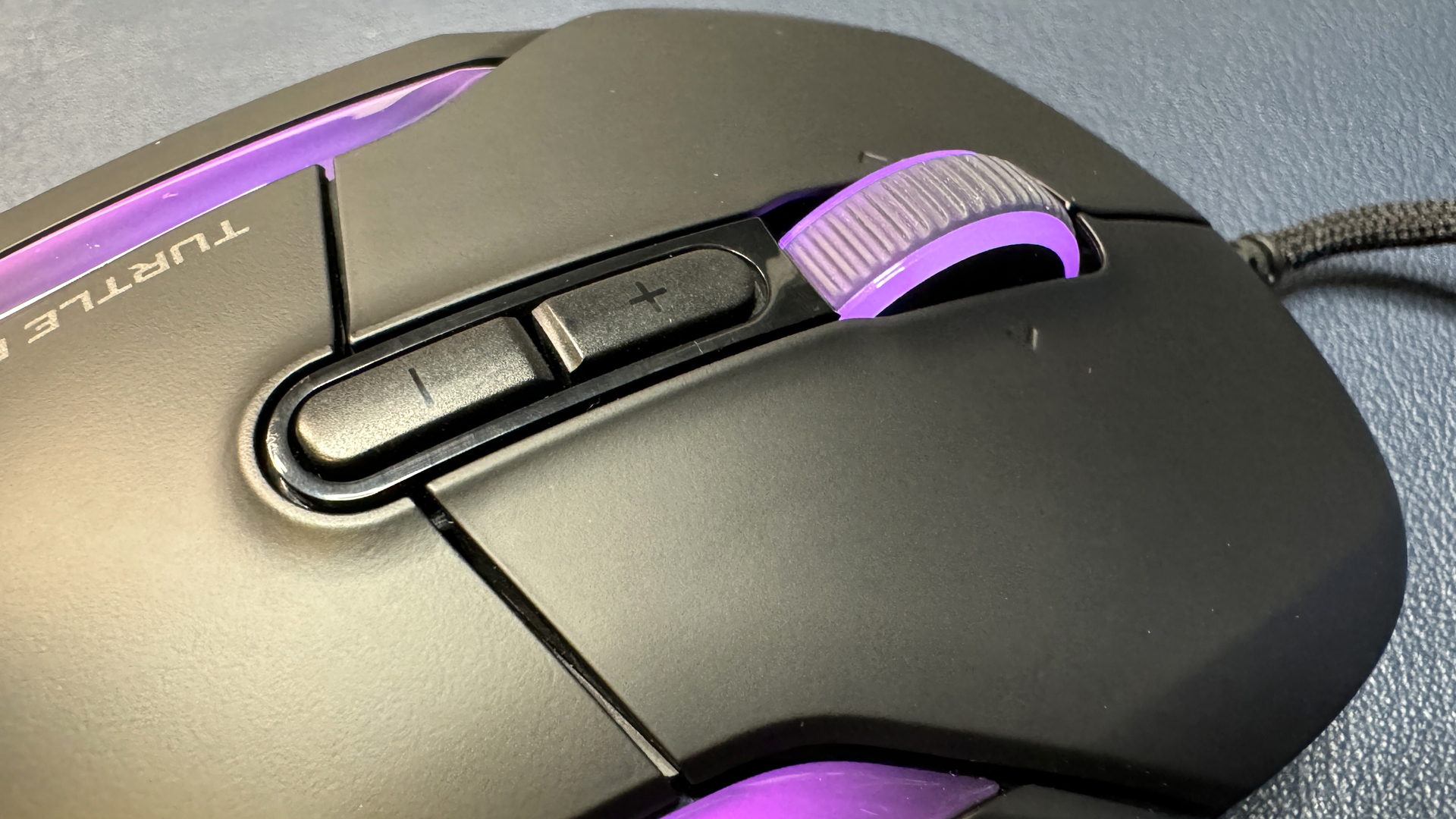
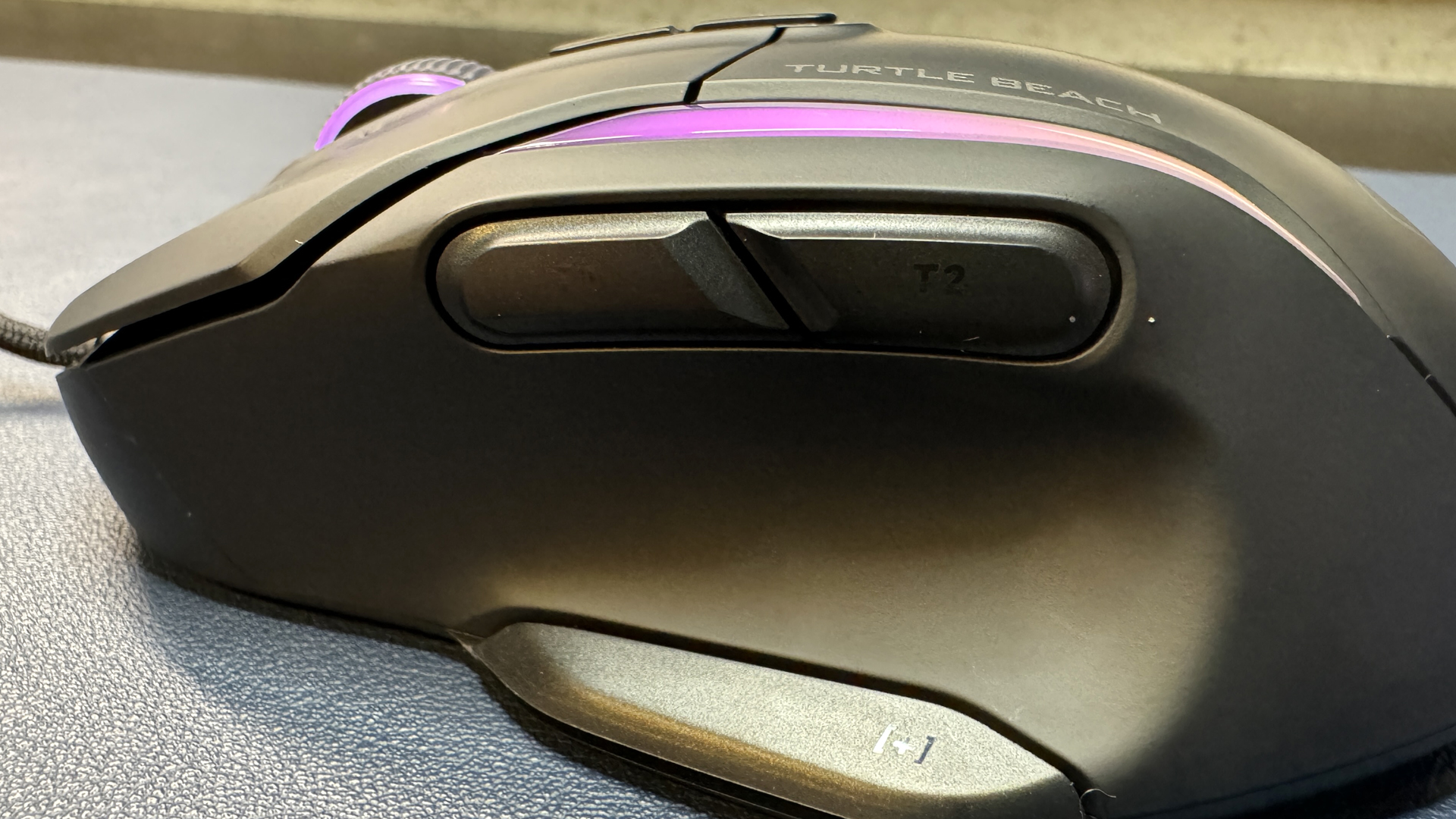
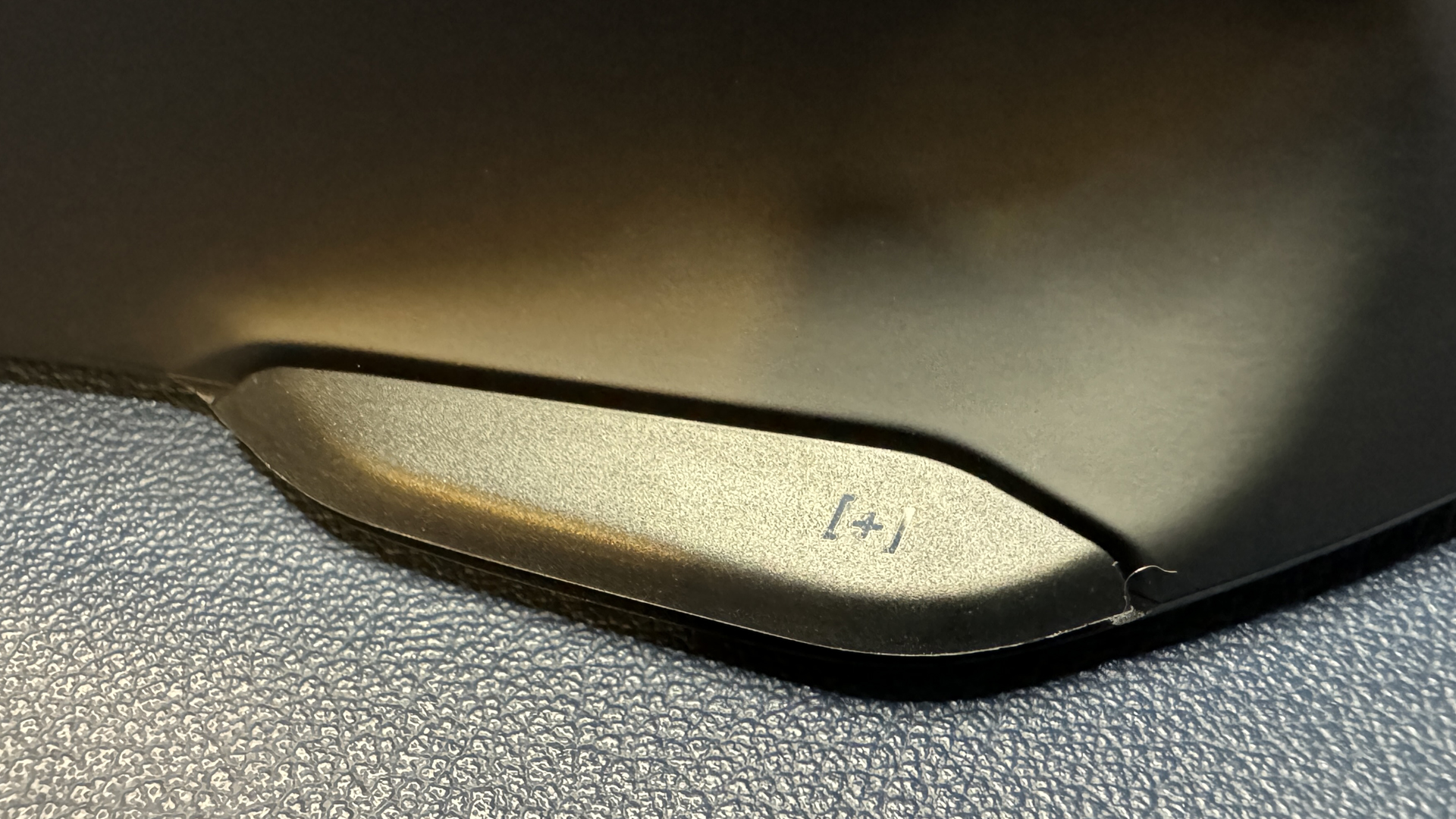
The Kone II has seven programmable buttons: left/right click, two thumb buttons, a thumb rest button, and DPI/profile switch buttons above the scroll wheel. The mouse's scroll wheel is a 4-way tilt wheel, which means it scrolls up and down and has a middle, right, and left click. All of these inputs are also programmable (including scroll up/down, though I don't think most users will reprogram those).
Like most gaming peripheral companies, Turtle Beach also offers a second layer of programmability, called "Easy Shift." Holding the Easy Shift button down (by default, the thumb rest button, but it can be reassigned) gives you access to the mouse's secondary functions, giving you almost twice as many buttons without adding more physical buttons.
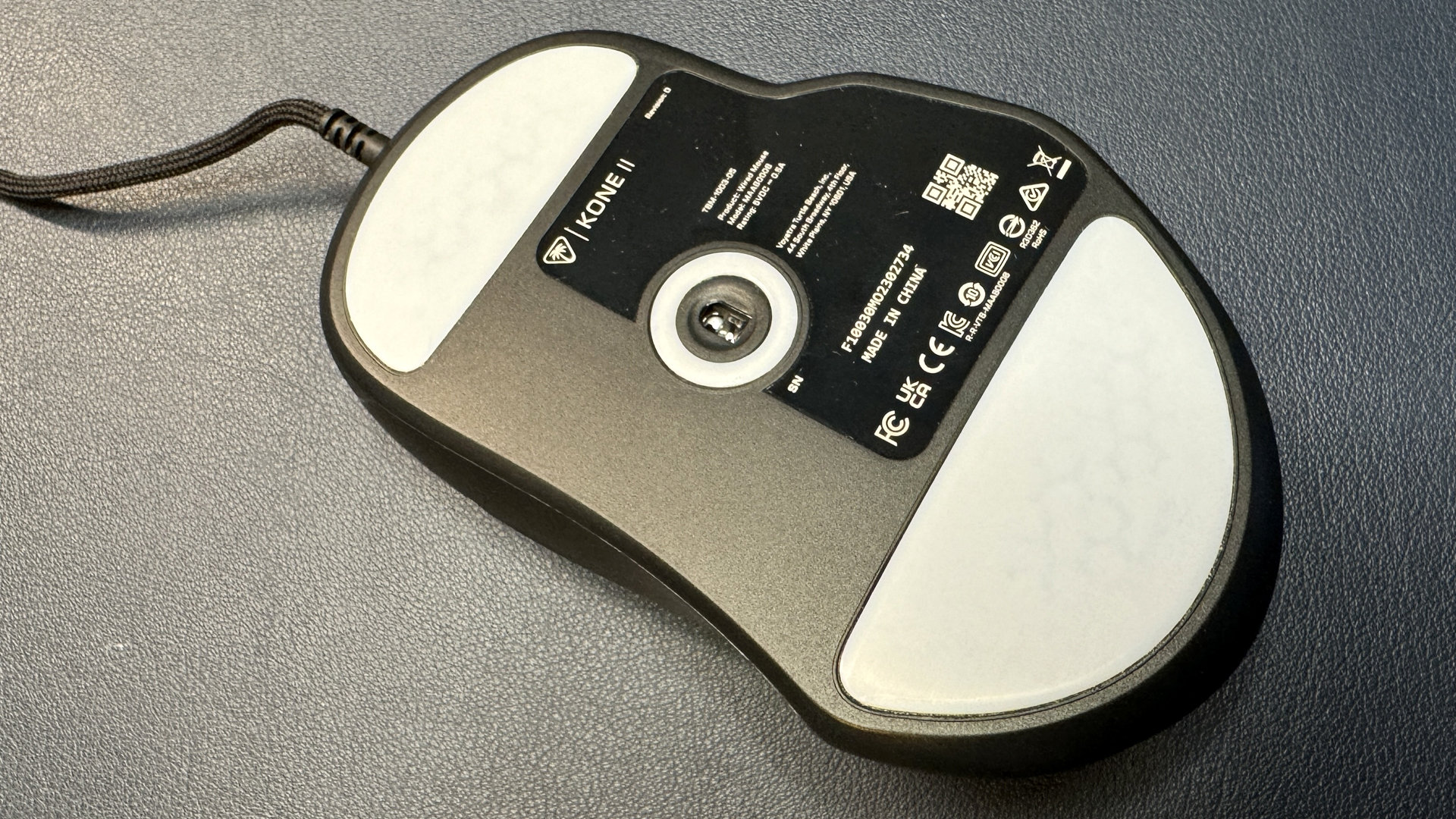
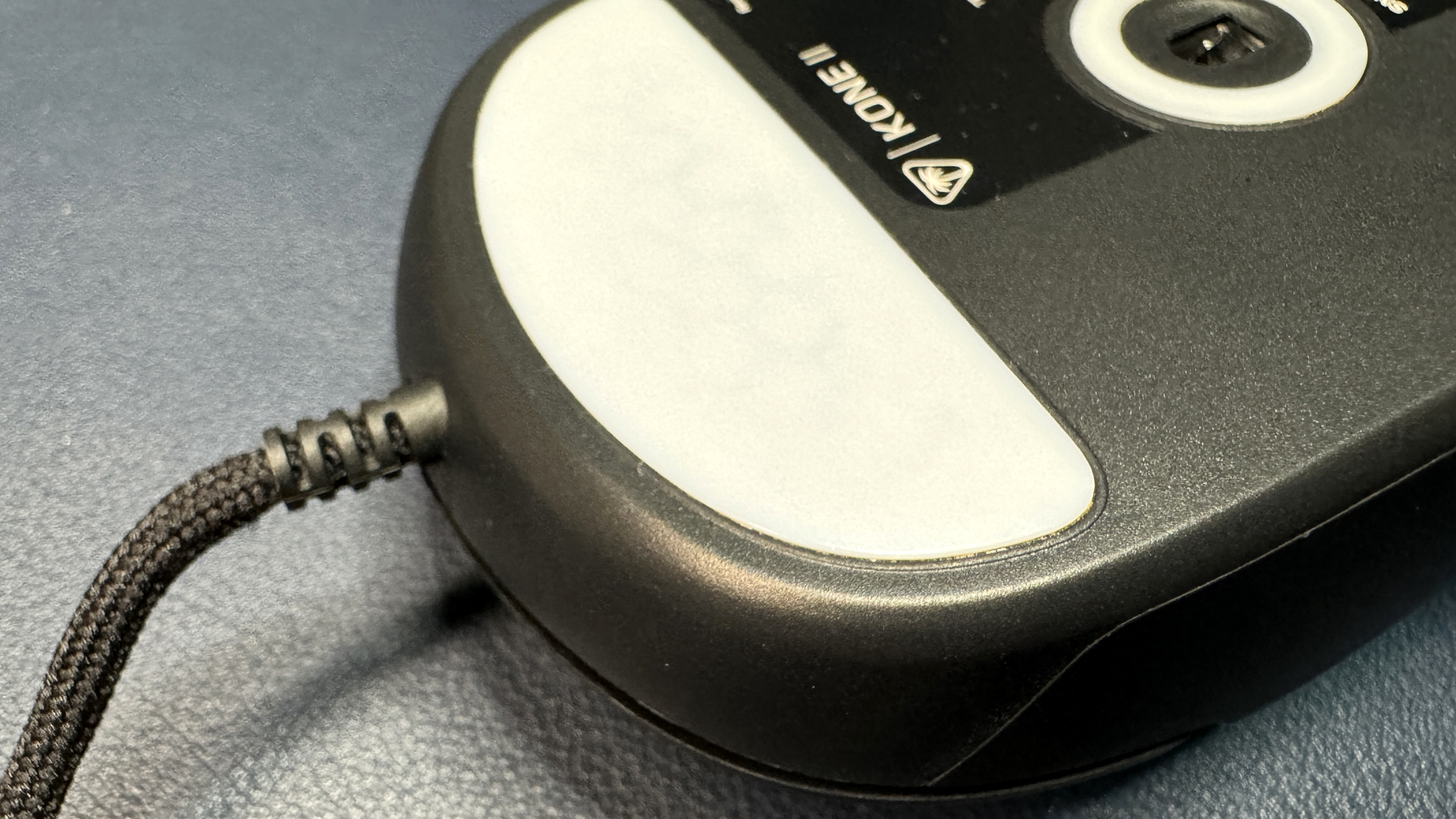
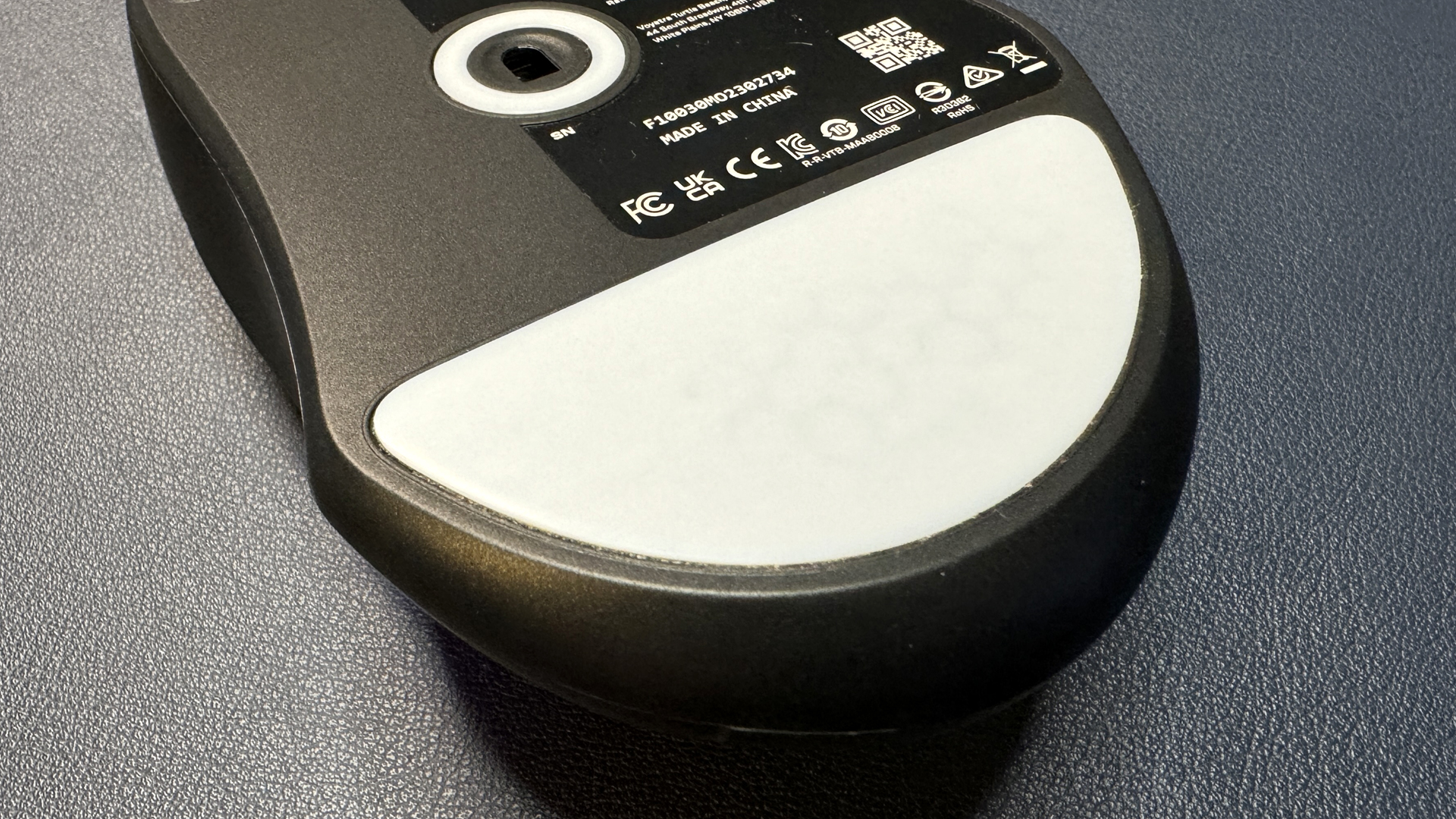
The bottom of the Kone II is pretty simple, with two large, smooth PTFE feet at either endm, as well as a strip of PTFE around the mouse's optical sensor. I'm not sure these mouse feet need to be quite this large, as the Kone II isn't very heavy, but... well, they are. And they certainly work, as the Kone II had no issues gliding swiftly over a variety of mouse surfaces (or moving between surfaces).
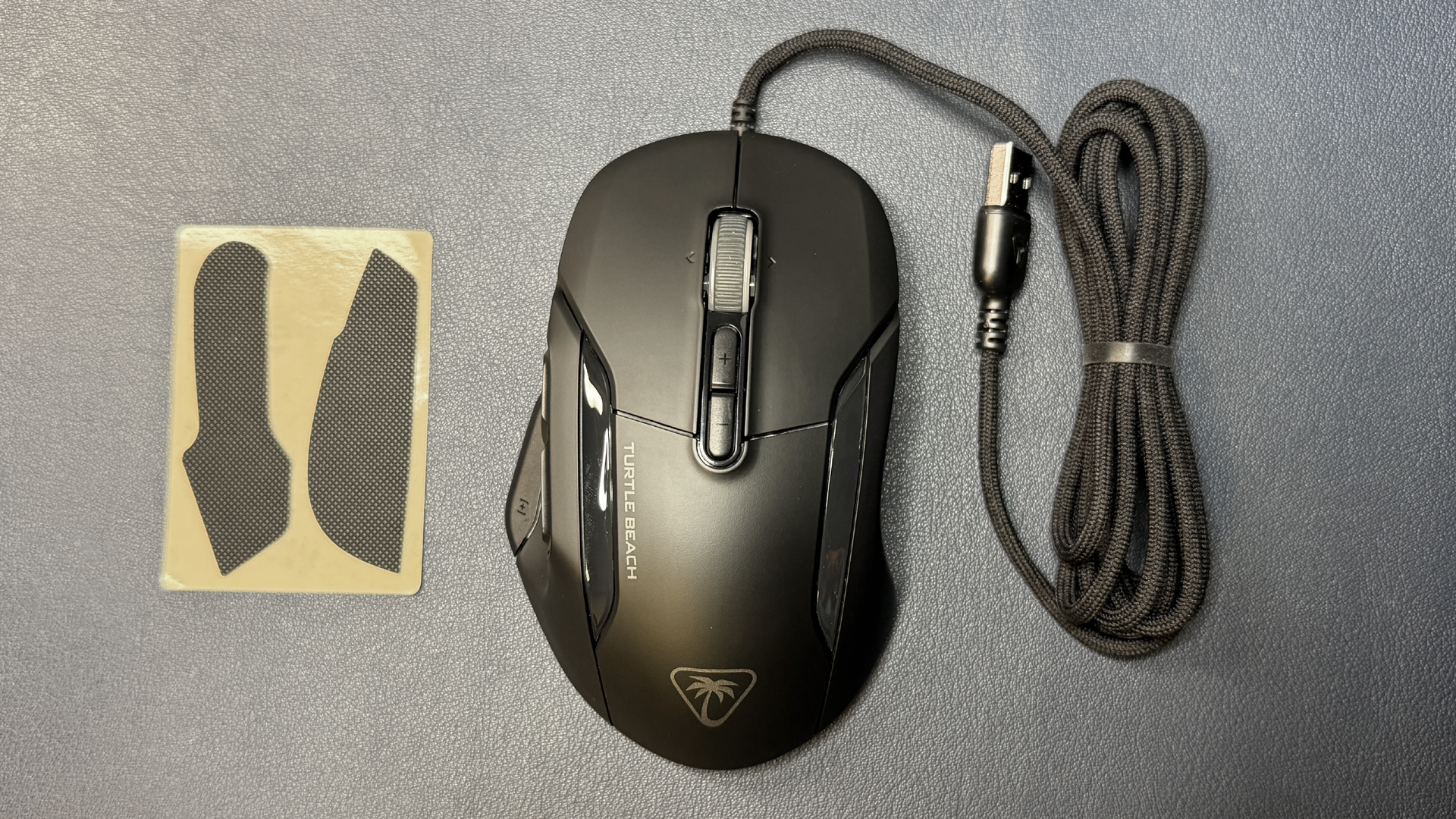
The Kone II comes with a non-detachable 5.9-foot (1.8m) USB-A cable. The braided cable is the brand's "PhantomFlex" cable, and it's fairly flexible with just a little cable drag. Also in the box are two strips of textured, rubbery grip tape, which are pre-cut to fit the sides of the mouse.
SPECS
| Sensor Model | Owl-Eye 26K Optical Sensor |
| Max Sensitivity | 26,000 DPI |
| Max Speed (IPS) | 650 IPS |
| Max Acceleration | 50 G's |
| Polling Rates | 1,000 Hz |
| Programmable Buttons | 7 |
| LED Zones | 3 |
| Cable | 5.9-ft PhantomFlex USB-A |
| Connectivity | Wired (USB-A) |
| Measurements (L x W x H) | 5.13 x 3.25 x 1.72 inches / 130.2 x 82.6 x 43.6 mm |
| Weight (excluding cable) | 3.17 oz / 90g |
| MSRP / Price at Time of Review | $69.99 |
| Release Date | Sept. 12, 2024 |
Performance of the Kone II
The Kone II sports Turtle Beach's Owl-Eye 26K optical sensor, which has a maximum sensitivity of 26,000 DPI and a maximum tracking speed of 650 IPS and can handle up to 50 G's of force. This is the brand's newest sensor — it's also in the brand's ultra-lightweight Burst II Air and Pure Air mice, and is an upgrade from the Owl-Eye 19K optical sensor found in the Kone XP Air.
The mouse's primary buttons feature the brand's TITAN optical switches, which are rated for up to 100 million clicks. The switches are tactile and clicky, and have a click that's lighter in weight than Razer's or Logitech's current optical switches. The rest of the buttons on the mouse also have tactile, clicky switches, making for a very satisfying switch experience all around.
All of the mouse's buttons are pretty large — even the thumb buttons and the DPI switch buttons are larger than average. This meant they were easy to find (and easy to differentiate), but it also meant that I was moving my thumb and forefinger a bit more than I normally do to switch between buttons. This wasn't an issue for me as I have long, flexible fingers, but it might not make for the most comfortable experience if you have shorter fingers or smaller hands.
I didn't love the mouse's tilt wheel, either. It's a notched scroll with soft, round notches that were somehow still a little too stiff for me (maybe I've been spoiled by dual-scrolling mice with smooth scroll, such as the Razer Basilisk V3 Pro and the Logitech G502 X Plus). And while the center click was fine, if a little loud (a very distinct click), the side clicks were a little mushy. It just wasn't the tilt wheel for me, but considering you don't usually see tilt wheels in this price range, perhaps I shouldn't be complaining.
The Kone II is a gaming mouse for an RPG marathon — it's big, smooth, comfortable, and wired. It's designed for palm grippers, not for claw or fingertip grippers (it's both too big and too slippery for these grips). As I mentioned earlier, it's lighter than it looks, but that doesn't mean it's light. The Kone II's bulky, slippery form factor is not for lifting — this is not a mouse I would recommend picking up. While the mouse's big PTFE skates do help it glide smoothly, it's not particularly speedy.
Features and Software of the Kone II
The Kone II works with Turtle Beach's (formerly Roccat's) Swarm II peripheral software. Upon plugging the Kone II in and opening up Swarm II, I was unsurprised to see the mouse needed a firmware update. (I don't think I've ever used a Turtle Beach/Roccat product that didn't need an immediate firmware update.) Luckily it was a quick, smooth update that didn't require a restart. Also, I used the mouse for a while before installing Swarm II, and it worked fine, so this didn't seem to be a critical firmware update.
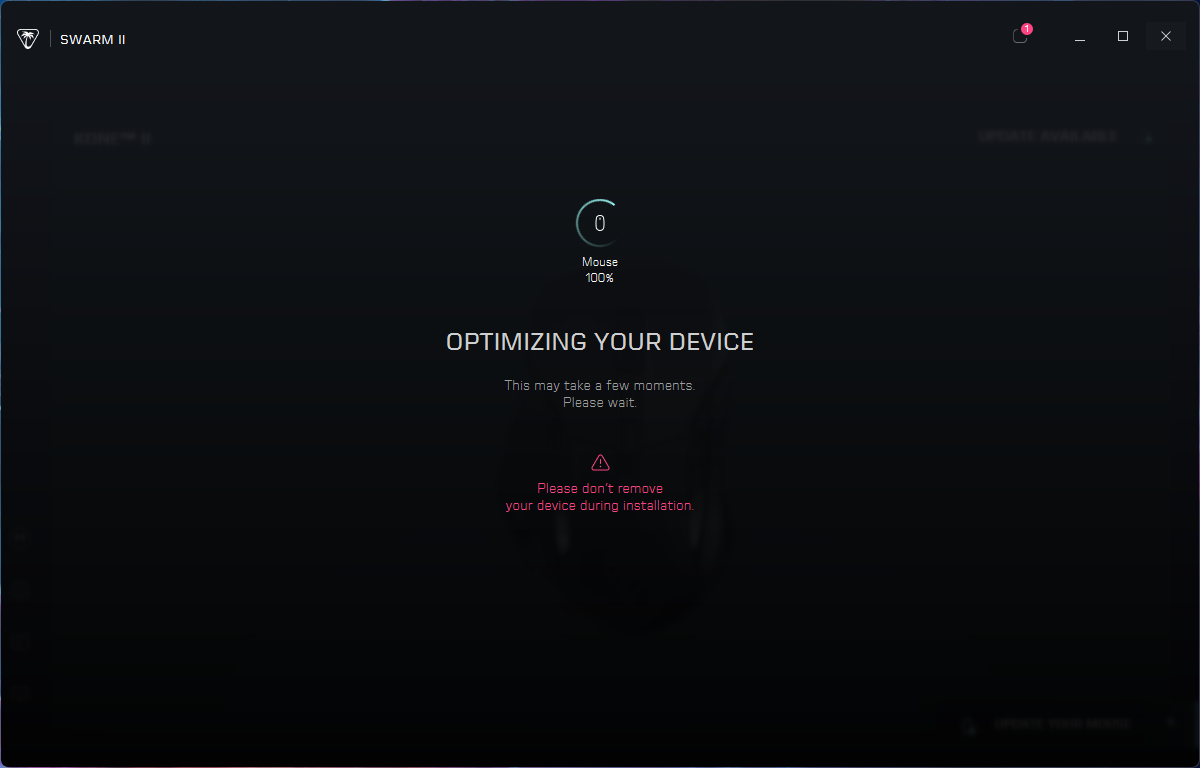
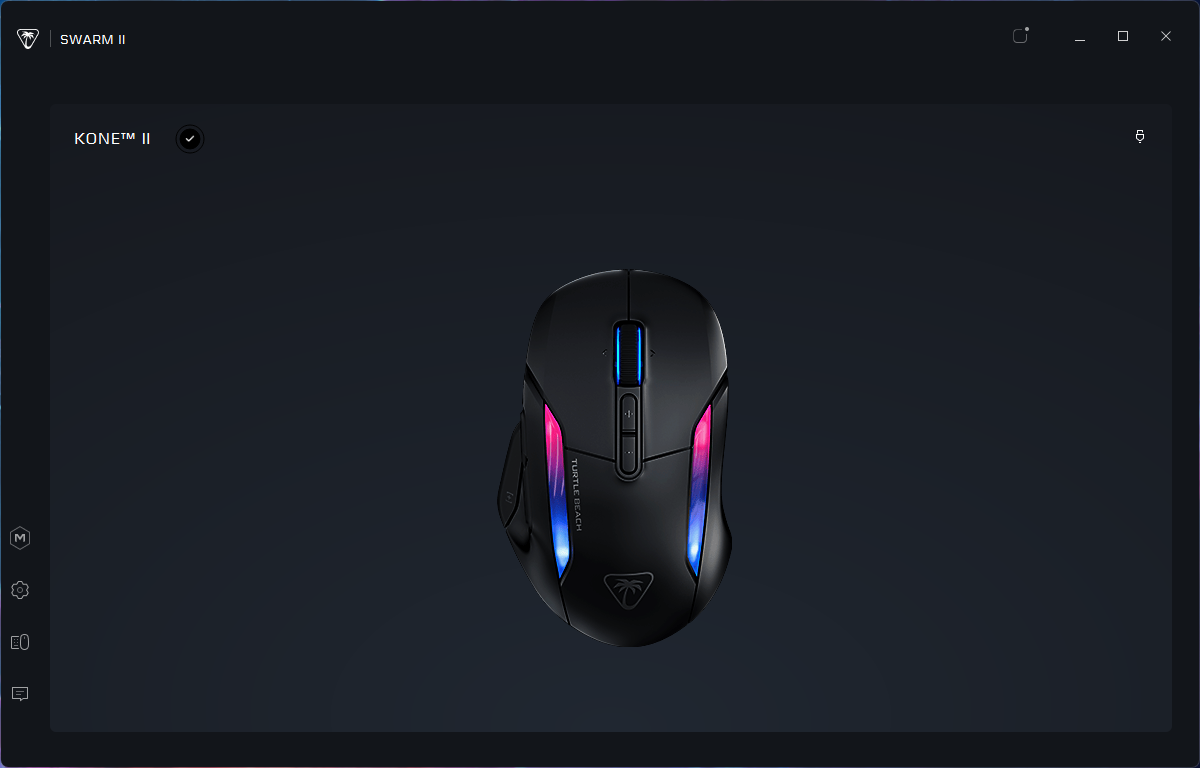
In addition to updating the mouse's drivers and firmware, the Swarm II software is where you can change various settings, such as polling rate, debounce time, standby mode, and angle snapping, and where you can set up and adjust the mouse's DPI steps.
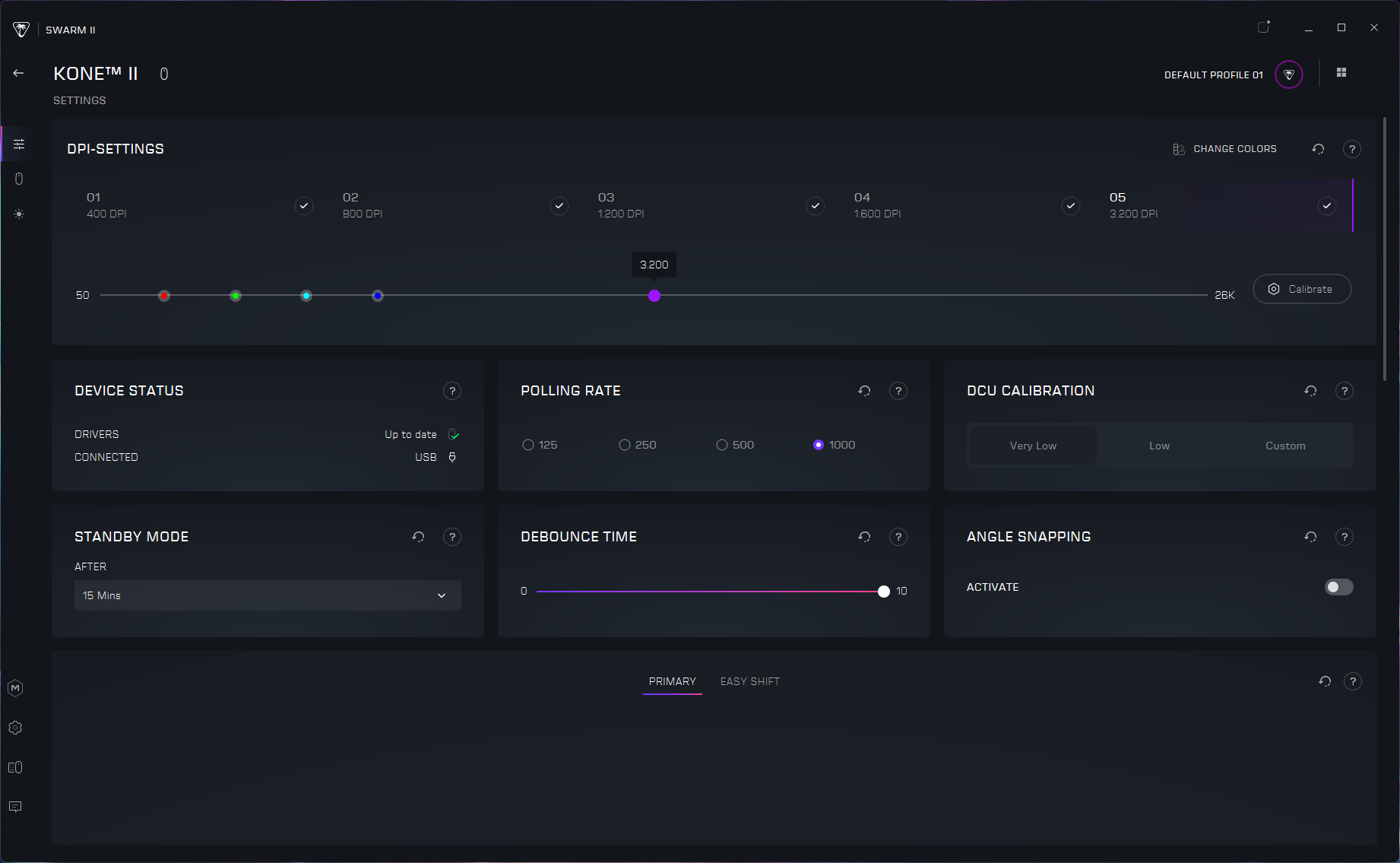
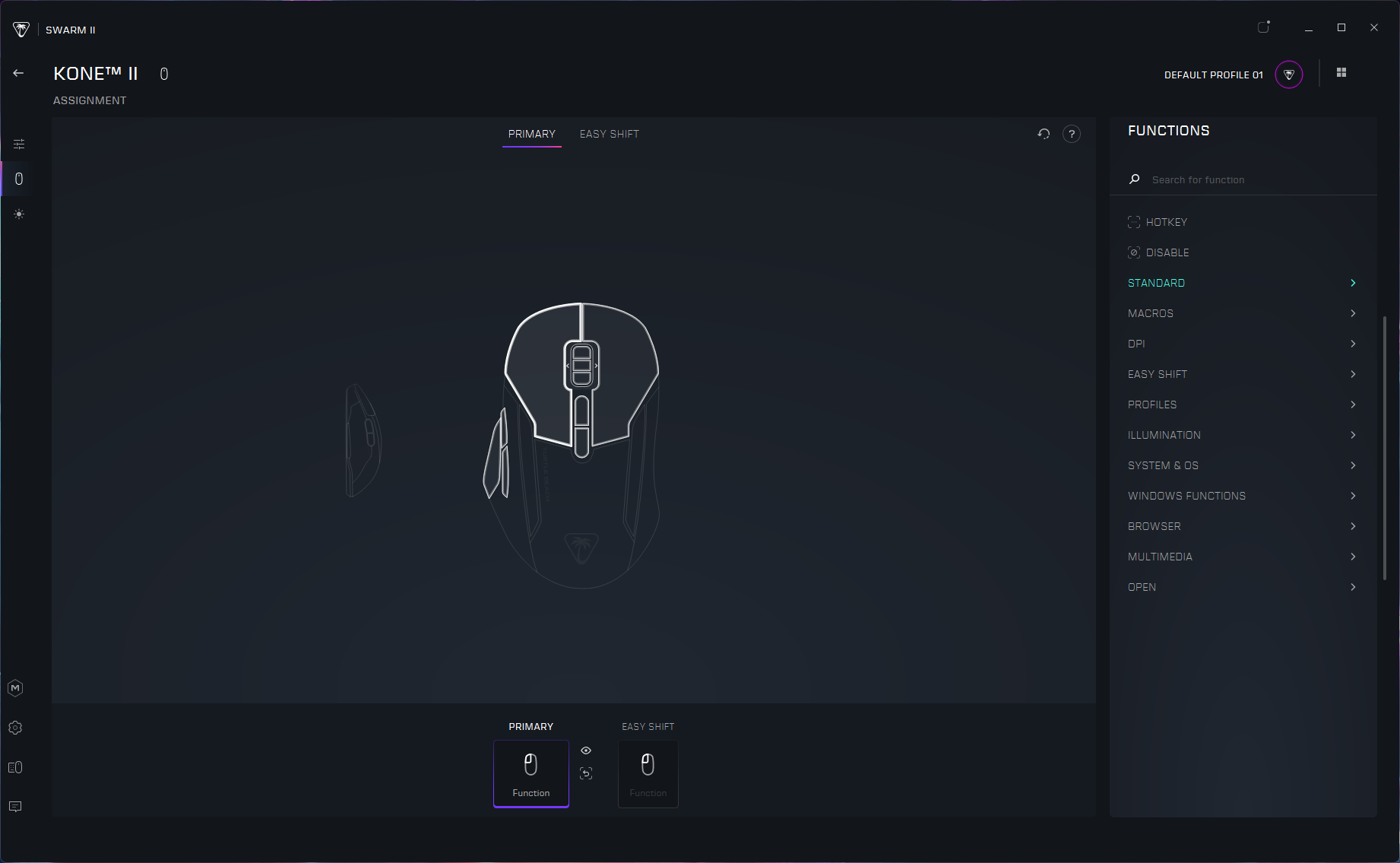
The software also lets you remap the mouse's programmable inputs — both the primary inputs and the secondary Easy Shift inputs. Remapping inputs is as simple as clicking the input you want to program and picking a function from a list of standard mouse, keyboard, system/OS, Windows, browser, and multimedia functions. You can also assign macros — there's a macro recorder in the software, as well as tons of pre-set macros for over 40 games and programs, including Apex Legends, Counter Strike: Global Offensive, Minecraft, and World of Warcraft, as well as Microsoft Office, Photoshop, and Team Speak 3.
According to Turtle Beach, the Kone II offers 23 programmable inputs with Easy Shift — which is technically true, but you're probably not going to reprogram your primary buttons or your scroll wheel.
You can also use the software to customize the Kone II's RGB lighting. The mouse technically has five RGB lighting zones — two in each side strip and one in the scroll wheel — but you can't program all five independently. The software offers six different lighting effects: AIMO, colorwave, fully lit, heartbeat, blink, and breathe.
The first two effects, AIMO and colorwave, offer very limited customization. With AIMO you can change the brightness and that's it; with colorwave you can change the brightness and the speed. AIMO is the company's unique "organically responsive" lighting effect (which I happen to love) while colorwave is your standard spectrum cycle.
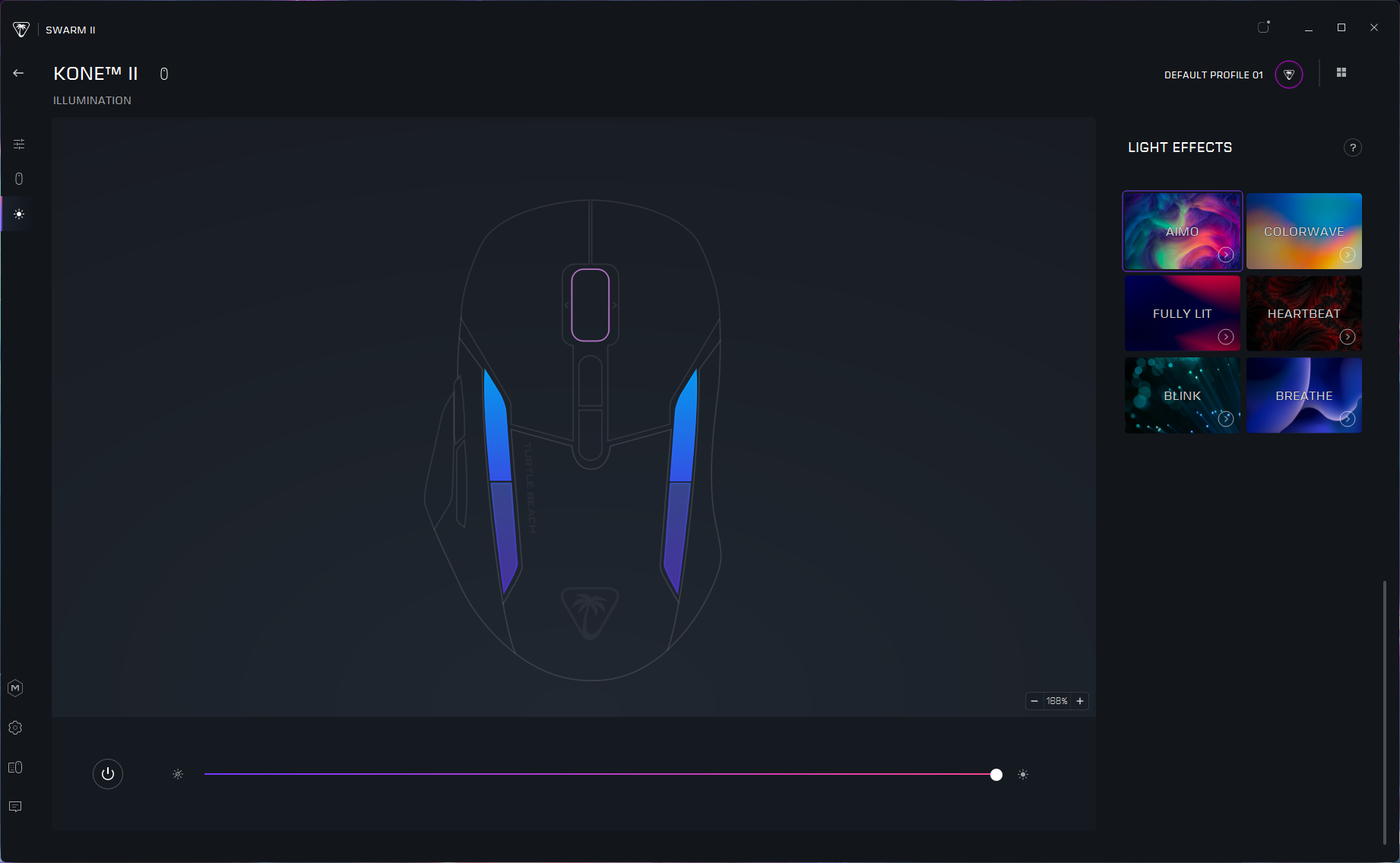
The other four effects let you change the colors as well as the brightness / speed. However, there are only three lighting zones for customization purposes — the scroll wheel, the top of both side strips, and the bottom of both side strips.
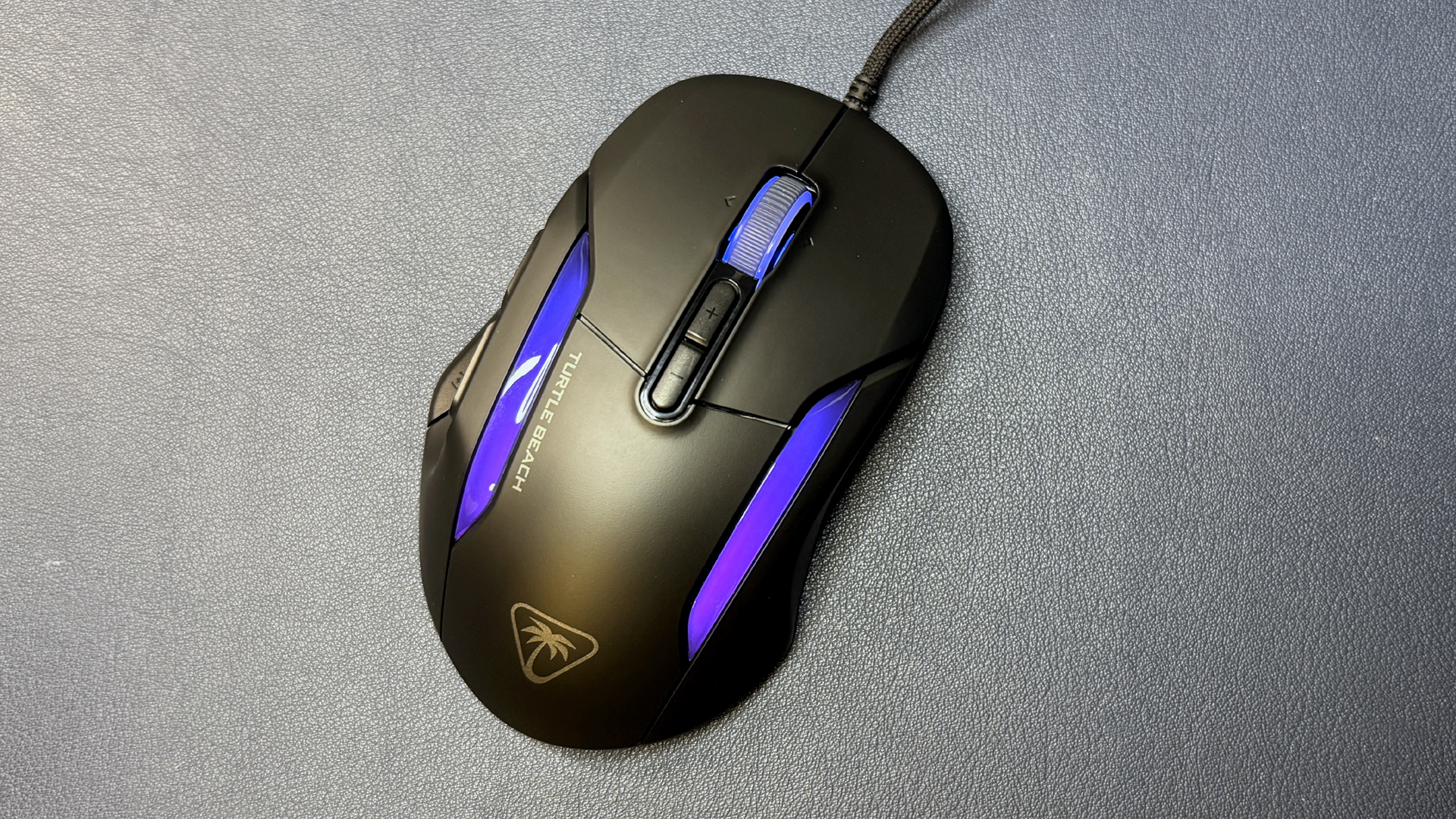
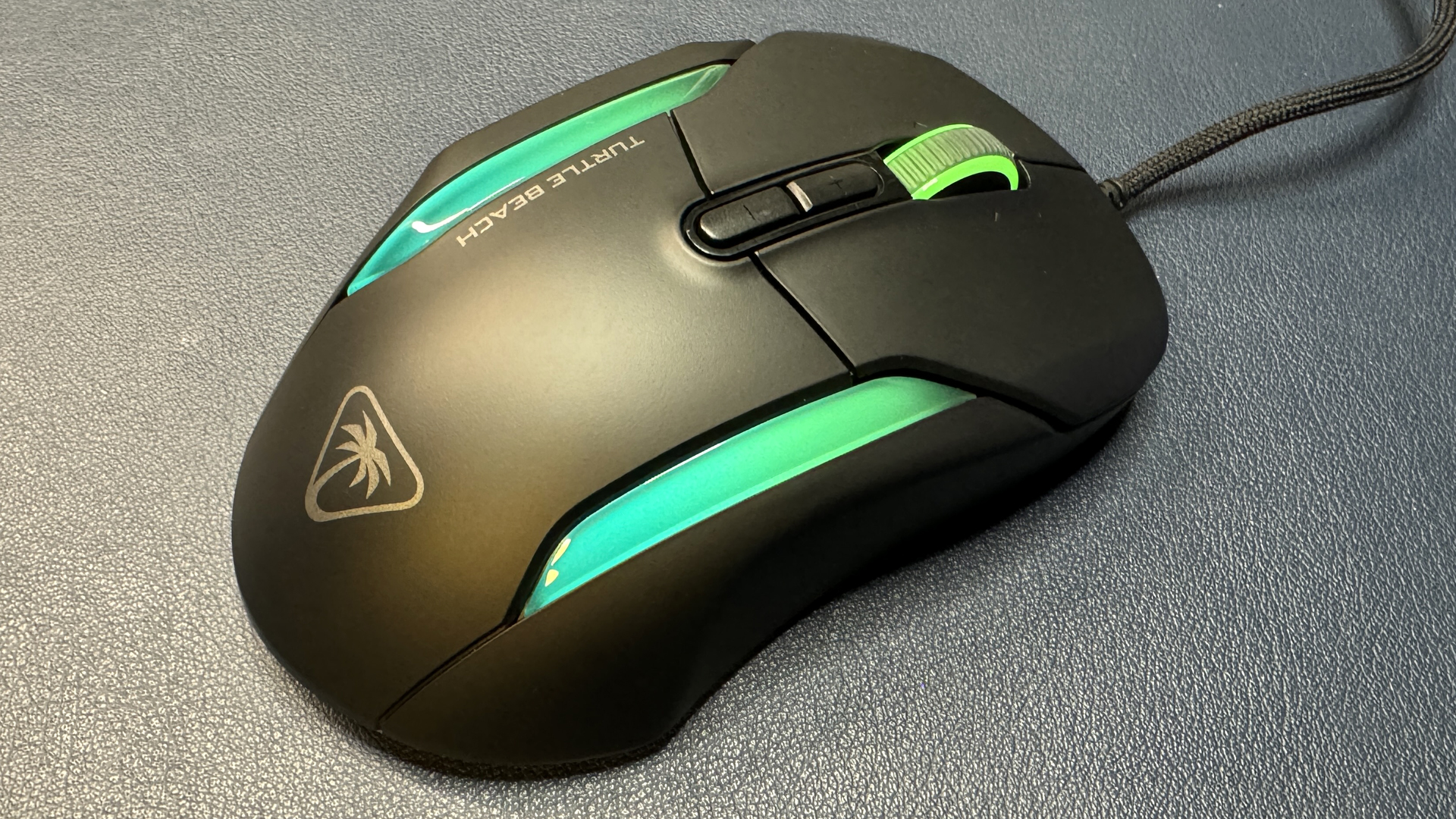
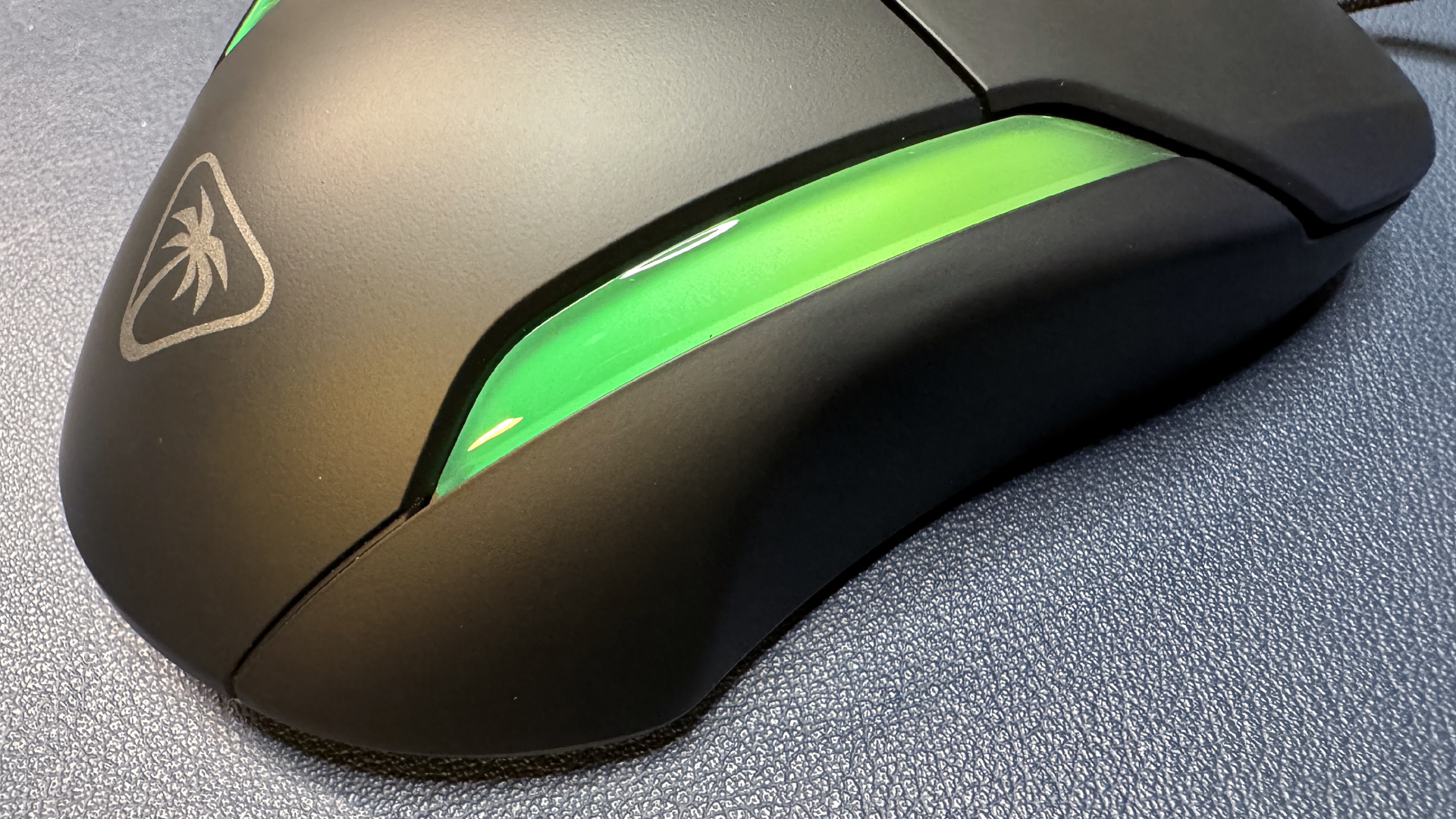
The Kone II's lighting customization is pretty limited compared to what you'll find in apps like Razer's Chroma... but I think it's fine. There are a couple of multi-color / spectrum options, and you can customize with up to three of your own colors; I don't see most people wanting a lot more than this. Razer's Chroma is unnecessarily complicated — most people want something that looks pretty and/or matches the rest of their setup, and basically nobody is going to program 17 different lighting zones with 32 multi-layered effects that trigger on various inputs.
Bottom Line
The Turtle Beach Kone II is a solid, mid-priced wired gaming mouse that performs well and feels good — if you have medium or larger hands — and is very comfortable for long gaming sessions. Its soft, smooth chassis is a little slippery, but this isn't too much of an issue for palm grippers, and the mouse comes with grip tape for the sides (as a note: it probably would have benefitted from grip tape for the primary buttons, too). It also looks pretty good with its bright, blended light strips, even if it's a little clunkier than other mice — I'm a big fan of the whole AIMO lighting situation, but even if you aren't, the Kone II doesn't implement its lighting in a polarizing way, the way some might argue the Kone XP Air does.
While the Kone II does have some features you won't see in cheaper mice, such as a 4-way tilt wheel and the ability to program everything (including inputs nobody ever programs), it's not the only option for sub-$100 wired gaming mice. Logitech's G502 Hero and Razer's Basilisk V3 have been out for a few years now, but both have similar specs with a few more buttons and dual-mode scroll wheels, and can frequently be found on sale for half the price of the Kone II. (The Kone II is lighter than both of those mice, but it's also larger and slipperier and therefore not any easier to pick up or zip across your desk.)

Sarah Jacobsson Purewal is a senior editor at Tom's Hardware covering peripherals, software, and custom builds. You can find more of her work in PCWorld, Macworld, TechHive, CNET, Gizmodo, Tom's Guide, PC Gamer, Men's Health, Men's Fitness, SHAPE, Cosmopolitan, and just about everywhere else.
-
MoxNix "It's designed for palm grippers, not for claw or fingertip grippers (it's both too big and too slippery for these grips)."Reply
Maybe if you have tiny hands. It's pretty much the same size as the older Roccat Kone mice. If you have big hands or even just long fingers like mine they're no good at all for a palm grip. Nobody makes a gaming mouse that's big enough for a palm grip with big hands.
If I put my palm on the back of one of my old Roccat Kone mice (I have 2 of them) my fingers hang more than an inch over front of the mouse and I have to curl my thumb back to use the side buttons. I'm forced to use a claw grip even though I much prefer a palm grip but at least that's better than fingertip grip. I have yet to see a gaming mouse that isn't either too small or too heavy to use with a fingertip grip.
Please learn to take into account that not everyone has small hands before making proclamations about what mouse is suitable for what grip. Your mouse reviews would be greatly improved if you took hand size into consideration and maybe even try asking someone with large hands what he thinks. -
UnforcedERROR Reply
The issue with this statement is that you're excluding intent of design. It sounds like you have much larger hands than most people, but that doesn't change the demographic a mouse might be aimed at. The Kone 2 is an ergo shape, and it's pretty large by mice standards, which means that while the marketing says it's suitable for "all grip types" it's primarily a palm-oriented design. Ergos trend towards palm, and claw/fingertip mice generally run smaller than this mouse. A more standard claw/fingertip design for larger hands is something like the Viper.MoxNix said:"It's designed for palm grippers, not for claw or fingertip grippers (it's both too big and too slippery for these grips)."
Maybe if you have tiny hands. It's pretty much the same size as the older Roccat Kone mice. If you have big hands or even just long fingers like mine they're no good at all for a palm grip. Nobody makes a gaming mouse that's big enough for a palm grip with big hands.
If I put my palm on the back of one of my old Roccat Kone mice (I have 2 of them) my fingers hang more than an inch over front of the mouse and I have to curl my thumb back to use the side buttons. I'm forced to use a claw grip even though I much prefer a palm grip but at least that's better than fingertip grip. I have yet to see a gaming mouse that isn't either too small or too heavy to use with a fingertip grip.
Please learn to take into account that not everyone has small hands before making proclamations about what mouse is suitable for what grip. Your mouse reviews would be greatly improved if you took hand size into consideration and maybe even try asking someone with large hands what he thinks.
So I get your frustration with being overlooked, but the intent of a review is to cover the main majority, not the minority. Your own admission is no mouse is large enough for you to palm grip: that doesn't remove the intent of the design or the user targets it was aimed at.
